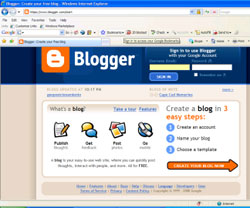Using Blogs in a History Classroom
Using the technology of blogging in the classroom to improve critical thinking and analysis skills.
Using a teacher-created blog in a history classroom is a way to engage students through a different medium. Students of today relate more and more to technology and will welcome a different way of learning. Using a teacher-created blog will also allow you and your students to exchange ideas in an asynchronous environment.
This teaching guide will assist teachers who want to set up their own blogs for their history classrooms. The first part of the guide describes how to create a blog. The second part of the guide suggests activities for improving students’ critical thinking and analysis skills in a history classroom.

- Choose a site. There are several places that a teacher can go to create a blog. Most of the sites are free and easy to set up. A popular site for creating a blog is Blogger which is owned by Google. Other sites include Wordpress and Edublogs. I have been using Blogger for three years and have been very happy with its ease and reliability. Setting up an account is simple and straightforward. Blogger allows you to set up your account in three easy steps. (See image right.)
- For Blogger and Edublogs, create a title and your own URL. The title can always be modified, but the URL is permanent so create wisely. The URL will be your choice. With Wordpress, you are downloading blogging software and then you need to subscribe to a web host (like Go Daddy), which charges a fee; you can then choose your own URL.
- Once your blog has been created you are ready to begin blogging. You will want to be clear with students, parents, and administrators about your expectations and reasoning behind using your blog. Also be sure to review your district’s Acceptable Use Policy with your students. You will want to contact your Instructional Technology (IT) department to make sure the blog will not be caught by your school’s filter. Occasionally access may be blocked if your school’s filter is too restrictive. If this happens you will need IT to adjust the filter.
- To start out, you will want to be the only one to post a topic for discussion. This will enable you to establish the topic and provide i instructions for students to follow when commenting. Once a topic has been posted with specific instructions, the students can post their comments. If you are using Blogger, you can regulate who is allowed to post comments. The "dashboard" in Blogger allows you to restrict comments to your students. You can also allow parents and members of the community to post comments by adjusting the settings in the dashboard of your Blogger account. You need to choose what method fits your situation best.
 The screenshot above shows what appears after a student clicks on the comment link. To leave a comment, the students type in the comment box, insert the word verification, and then choose their identity (assigned by the teacher). As the creator of the blog, you will be able to edit and remove any comments that you deem inappropriate.
The screenshot above shows what appears after a student clicks on the comment link. To leave a comment, the students type in the comment box, insert the word verification, and then choose their identity (assigned by the teacher). As the creator of the blog, you will be able to edit and remove any comments that you deem inappropriate.
There are several different ways a teacher-created blog can be used in a history classroom. These include ways to:

- Have students post ideas and opinions about topics discussed in class.
- Have students post potential thesis statements and allow other students to comment on each thesis. (See example below)

When you decide to create your own blog there are some pitfalls to avoid.
- Start slow and small; don’t try blogging with all your classes at once. You will want to focus on one class at a time while getting comfortable with your blog. Trying to do too much too fast will become frustrating and overwhelming.
- Remind students to omit their last name and other personal information when they post comments. My students use only a first name or a nickname and their class period.
Thank you to Dr. Helen Rallis and Dr. Terry Shannon at the University of Minnesota-Duluth who advised me with my M.Ed with an emphasis in technology and turned me on to blogging.
For more information
Read more about blogging and get examples and best practices from other educators in the Tech for Teachers section.